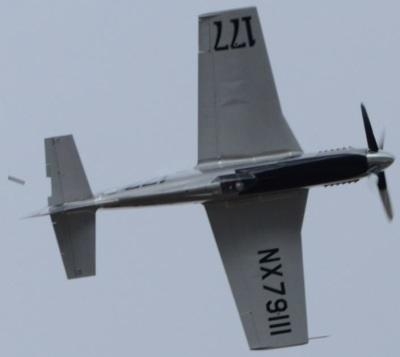Modifications To Galloping Ghost Weakened The Airplane Structurally
The NTSB determined at a meeting Monday in Washington, D.C. that deteriorated locknut inserts found in the highly modified North American P-51D airplane that crashed during the 2011 National Championship Air Races in Reno, Nevada, allowed the trim tab attachment screws to become loose, and even initiated fatigue cracking in one screw. This condition, which resulted in reduced stiffness in the elevator trim system, ultimately led to aerodynamic flutter at racing speed that broke the trim tab linkages, resulting in a loss of controllability and the eventual crash.

On September 16, 2011, as the experimental single-seat P-51D airplane “The Galloping Ghost,” traveling about 445 knots, or 512 mph, in the third lap of the six-lap race, passed pylon 8, it experienced a left-roll upset and high-G pitch up. During the upset sequence, the airplane’s vertical acceleration peaked at 17.3 G, causing incapacitation of the pilot. Seconds later, a section of the left elevator trim tab separated in flight. The airplane descended and impacted the ramp in the spectator box seating area, killing the pilot and 10 spectators and injuring more than 60 others.
“In Reno, the fine line between observing risk and being impacted by the consequences when something goes wrong was crossed,” said NTSB Chairman Deborah A. P. Hersman. “The pilots understood the risks they assumed; the spectators assumed their safety had been assessed and addressed.”
Contributing to the accident were the undocumented and untested major modifications made to the airplane, as well as the pilot’s operation of the airplane in the unique air racing environment without adequate flight testing.
The nearly 70-year-old airplane had undergone numerous undocumented modifications. The modifications, designed to increase speed, included shortening of the wings, installation of a boil-off cooling system for the engine, increasing the elevator counterweights, modification of the pitch trim system, and changing the incidence of the horizontal and vertical stabilizers.

"If you want to go out and fly fast and try to win, that's one thing," said Board Member Robert Sumwalt. "If you're modifying an aircraft without fully understanding how the modifications can affect the aerodynamics, you're playing Russian roulette."
Although the FAA required that a flight standards district office be notified in writing of any major changes made to The Galloping Ghost before it could be flown, investigators could find no records that such notifications were made except for the installation of the boil-off cooling system. The undocumented major modifications were identified through wreckage examinations, photographic evidence, and interviews with ground crewmembers.
In April, while the investigation was ongoing and after the NTSB’s investigative hearing in January on air race and air show safety, the NTSB issued 10 safety recommendations to the Reno Air Racing Association, the National Air racing Group Unlimited Division, and the FAA. These recommendations addressed:
- Requiring engineering evaluations for aircraft with major modifications.
- Raising the level of safety for spectators and personnel near the race course.
- Improving FAA guidance for air race and course design.
- Providing race pilots with high-G training and evaluating the feasibility of G-suit requirements for race pilots.
- Tracking the resolution of race aircraft discrepancies identified during prerace technical inspections.
Although no additional safety recommendations were issued Monday, the Board reclassified nine existing recommendations. Most are considered closed by the board after "acceptable action" on the part of the parties named in those recommendations. Recommendations dealing with eligibility requirements for aircraft with major modifications (A 12 9 and A-12-13) are now classified “Open—Acceptable Response”. A tenth safety recommendation, issued to the FAA, which addressed air race and course design guidance was reclassified as “Open—Acceptable Response” on July 25, 2012.
“It’s good news for the air races that so many of our recommendations have been addressed,” said Chairman Hersman. “We will continue to push for the full implementation of all of our safety recommendations.”

 ANN's Daily Aero-Term (04.26.24): DETRESFA (Distress Phrase)
ANN's Daily Aero-Term (04.26.24): DETRESFA (Distress Phrase) ANN's Daily Aero-Linx (04.26.24)
ANN's Daily Aero-Linx (04.26.24) Airborne 04.22.24: Rotor X Worsens, Airport Fees 4 FNB?, USMC Drone Pilot
Airborne 04.22.24: Rotor X Worsens, Airport Fees 4 FNB?, USMC Drone Pilot Airborne 04.24.24: INTEGRAL E, Elixir USA, M700 RVSM
Airborne 04.24.24: INTEGRAL E, Elixir USA, M700 RVSM Airborne-NextGen 04.23.24: UAVOS UVH 170, magni650 Engine, World eVTOL Directory
Airborne-NextGen 04.23.24: UAVOS UVH 170, magni650 Engine, World eVTOL Directory





